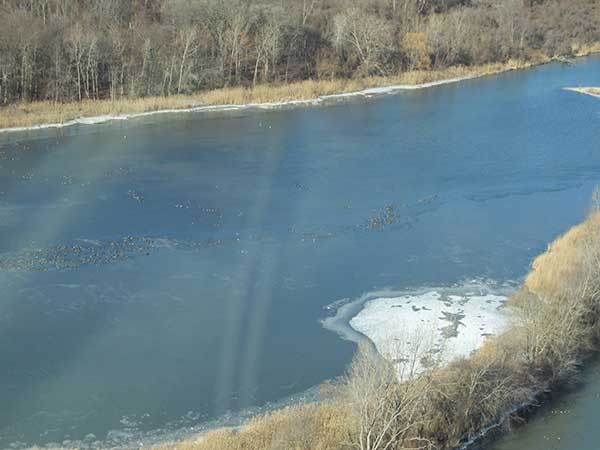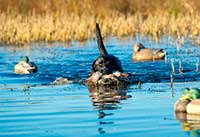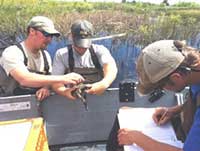- Details
(Provided by Michigan DNR)
 Michigan monitors waterfowl populations from the sky.
Michigan monitors waterfowl populations from the sky.
Michigan DNR wildlife staff members recently took to the sky in small aircraft to observe and count ducks, geese and swans on southeast Michigan's waterways this winter. They observed 157,028 ducks, 33,468 geese and 5,896 swans in the 2016 survey.
In the 2015 survey, observers counted 173,386 ducks, 20,350 geese and 4,365 swans. Goose and swan observations increased in 2016, while duck observations were down about 9 percent.
"The ducks were spread out this year with the mild winter and all the open water," said Joe Robison, field operations manager for the DNR Wildlife Division's Southeast Region. "We did not count as many ducks in this year's survey, but we believe that duck abundance is similar to last year."
Since 1991, the state of Michigan has cooperated with other states, the U. S. Fish and Wildlife Service, Canadian provinces and the Canadian Wildlife Service in conducting aerial surveys of wintering ducks and geese. This survey is commonly referred to as the Mid-Winter Waterfowl Survey.
Population estimates from Michigan, Minnesota and Wisconsin are included in estimates of waterfowl abundance and are needed for establishing annual waterfowl hunting season frameworks for the Mississippi, Central and Pacific Flyways. The Mid-Winter Waterfowl Survey has been especially important for evaluating waterfowl populations, monitoring winter migratory patterns and planning habitat management for these species.
Southeast Michigan, especially areas near western Lake Erie, the Detroit River and Lake St. Clair, is one of the most important areas in North America for migrating birds. Billions of birds migrate through this region each spring and fall. In addition, many waterfowl species spend the winter on the open water of the lakes and rivers of southeast Michigan.
The DNR, U.S. Fish and Wildlife Service and other partners are hosting a yearlong celebration of the 100th anniversary of the Migratory Bird Treaty. The celebration began Jan. 1, 2016.
The year 2016 marks the centennial of the Convention between the United States and Great Britain (for Canada) for the Protection of Migratory Birds (also called the Migratory Bird Treaty), signed Aug. 16, 1916. The Migratory Bird Treaty, three other treaties signed later, and the Migratory Bird Treaty Act form the cornerstones of efforts to conserve birds that migrate across international borders.
To learn more about the Migratory Bird Treaty centennial, visit www.fws.gov/birds/MBTreaty100.
- Details
(Provided by Indiana DNR)
Reynolds Creek Gamebird Habitat Area in Porter County now has two units available for waterfowl hunting.
These units will be included in the daily draw at the Kingsbury Fish & Wildlife Area check-station at 4:30 a.m. Central Time.
There will be one party (2 or 3 hunters per party) per unit with hunts offered on Sundays and Wednesdays only.
Shooting times will be 1/2 hour before sunrise to 1 p.m. Central Time. In addition to all state and federal regulations, hunters are limited to 25 shot-shells per hunter per day.
For additional information call the Kingsbury office at (219) 393-3612. Office hours are Monday through Friday, 7:30 a.m. until 2 p.m. Central Time.
- Details
(Provided by Indiana DNR)
The regular-season waterfowl dates and late-season Canada goose dates for Indiana have been finalized.
The United States Fish and Wildlife Service accepted the dates as proposed, with no changes.
Season dates for ducks, coots and mergansers are:
- North Zone: Oct. 24 to Dec. 13 and Dec. 19-27
- Central Zone: Oct. 31 to Nov. 8 and Nov. 21 to Jan. 10
- South Zone: Oct. 31 to Nov. 8 and Nov. 28 to Jan. 17
The daily bag limit for ducks in all zones is six, including no more than four mallards (of which no more than two can be hens), three scaup, three wood ducks, two pintails, two redheads, two canvasbacks, one black duck and one mottled duck. The daily bag limit for coots is 15. The daily bag limit for mergansers, separate from ducks, is five, of which no more than two can be hooded mergansers. The possession limit is three times the daily bag limit.
- Details
(Provided by Michigan DNR)
 Check out Michigan's managed waterfowl areas for quality huntsHunters who have not been introduced to Michigan's Wetland Wonders - the DNR's managed waterfowl areas - have a unique opportunity to get to know five of them this year before duck season begins this fall. Open houses are scheduled for early October at the three Saginaw Bay areas, as well as at the Lake St. Clair and Lake Erie areas.
Check out Michigan's managed waterfowl areas for quality huntsHunters who have not been introduced to Michigan's Wetland Wonders - the DNR's managed waterfowl areas - have a unique opportunity to get to know five of them this year before duck season begins this fall. Open houses are scheduled for early October at the three Saginaw Bay areas, as well as at the Lake St. Clair and Lake Erie areas.
"The managed areas were really put together to provide high-quality waterfowl hunts in areas that would attract and hold ducks and geese," said Joe Robison, a wildlife biologist who supervises the five managed waterfowl areas in southeast Michigan. "That's what these areas were built for and that's what we're striving for.
"We manipulate water levels and provide balanced food sources," he continued. "We have crops of corn, buckwheat and millet, as well as good natural wild duck food - barnyard grass, wild millet and smartweed. And they're also all production areas, so we maintain prairie grass and nesting cover.
"You want to have a diversity of food, cover and water, and we've got that."
All managed waterfowl areas include refuge areas, where no hunting is allowed. Area managers conduct weekly surveys of refuges and post population estimates, as well as the habitat conditions, on the DNR website.
- Details
(Provided by Michigan DNR)
 DNR Duck Banding Showcased on DiscoveringEfforts by a Michigan DNR crew to band ducks at the Portage Marsh in Delta County were showcased recently on an episode of "Discovering" a weekly outdoors program produced by Brian Whitens and broadcast at on WLUC-TV6, Marquette.
DNR Duck Banding Showcased on DiscoveringEfforts by a Michigan DNR crew to band ducks at the Portage Marsh in Delta County were showcased recently on an episode of "Discovering" a weekly outdoors program produced by Brian Whitens and broadcast at on WLUC-TV6, Marquette.
The duck banding was part of the DNRís goal to manage for sustainable populations of wildlife species. The DNRís objective is to manage game populations to provide hunting and trapping opportunities while maintaining populations in balance with available habitat, land use practices and stakeholder values.




